Freedom
HUNDREDTH ANNIVERSARY OF THE BATTLES OF GUČEVO AND MAČKOV KAMEN IN 1914
Battle above the Clouds
The amazing heroism is the eternal measure and fate of defenders of Serbia. The Battle of Drina is one of the bloodiest and most incredible ones in World War I. In difficult circumstances, lacking ammunition and equipment, Serbian warriors held off 215.000 Austro-Hungarians for two months, without rest or shifts. In five days of the almost mythical drama on Mačkov Kamen, more than 8.000 Serbs and about 30.000 Austro-Hungarians were killed. And each chapter of the Battle of Gučevo, from the distance between the battle lines to the way of providing supplies and communication, has forever become part of anthologies of warfare
Text and photo: Nenad Marković
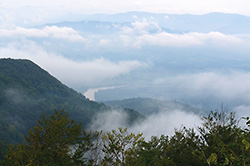 The achievements of the Serbian army in World War I have always deeply struck me – says Richard Carl (81), retired colonel of the American army, former professor of military history at West Point, while walking in Gučevo, the mountain where bitter fights took place a hundred years ago, famous as the Battle above the Clouds. – It is a great story only a few know about, about the fight and magnificent victory of a small nation. What Serbia accomplished then, what her soldiers-peasants achieved fighting without equipment and ammunition, with love for their homeland and people, defending their homes with their lives, should be known. As a soldier, I can understand the soldier’s soul, and here I found the one that made a peasant become a soldier. In order to win a war, one must be a good man. You made that happen. The achievements of the Serbian army in World War I have always deeply struck me – says Richard Carl (81), retired colonel of the American army, former professor of military history at West Point, while walking in Gučevo, the mountain where bitter fights took place a hundred years ago, famous as the Battle above the Clouds. – It is a great story only a few know about, about the fight and magnificent victory of a small nation. What Serbia accomplished then, what her soldiers-peasants achieved fighting without equipment and ammunition, with love for their homeland and people, defending their homes with their lives, should be known. As a soldier, I can understand the soldier’s soul, and here I found the one that made a peasant become a soldier. In order to win a war, one must be a good man. You made that happen.
The bloodiest battles of the Serbian army in World War I took place within the Battle of Drina, especially in Gučevo above Banja Koviljača and Mačkov Kamen near Krupanj. Serbian allies were doing badly, the enemy was marching towards Paris, Russians were suffering losses in Galicia. Serbia was therefore requested to conduct an offensive against Austro-Hungary, so that its troops would remain in this area. Fulfilling the requests, the Serbian army moved to Srem on September 5 and achieved significant successes. Meanwhile, the commander of the Austro-Hungarian forces in the Balkans Oscar von Potiorek decided to begin the second invasion into Serbia on the Drina, thereby stopping the Serbian offensive and moving towards Valjevo. The Fifth and the Sixth Army started across the Drina in the night between September 7 and 8, to confront the Second and Third Serbian Army. Standing before 215 thousand Austro-Hungarians with 500 cannons and 400 machineguns were 200 thousand Serbian soldiers with 306 cannons, 114 machineguns and lack of ammunition. The bloody battle begins.
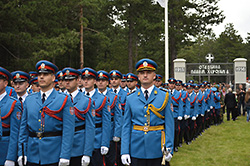 In order to advance towards Valjevo, the enemy had to conquer Gučevo and its ridges. In the first twenty-odd days, they suffered big losses, without fulfilling the plan. Near the end of September, the front stabilizes, the armies make burrows in conquered positions and the exhausting trench warfare begins. The most severe fights took place in Eminove Vode and Kulište, defended by the strengthened Combined Division. While the aggressor forces were regularly shifted, the 6th Supernumerary Regiment endured the entire battle in Eminove Vode without any shifts. In order to advance towards Valjevo, the enemy had to conquer Gučevo and its ridges. In the first twenty-odd days, they suffered big losses, without fulfilling the plan. Near the end of September, the front stabilizes, the armies make burrows in conquered positions and the exhausting trench warfare begins. The most severe fights took place in Eminove Vode and Kulište, defended by the strengthened Combined Division. While the aggressor forces were regularly shifted, the 6th Supernumerary Regiment endured the entire battle in Eminove Vode without any shifts.
Even today, the Gučevo woods hide trenches and craters, traces of the horrible battle. In the autumn of 1914, the mountain was almost bare from the fire effects. If one looks carefully, he may find rusted shells, broken bayonets, parts of guns, buttons and uniform buckles. The glade with the memorial ossuary dedicated to the heroes of Gučevo has a view over the Bosnian mountain, the winding Drina and Loznica in the valley. Clouds silently move through the trees, like the spirits of heroes who left their lives here, in this mountain – the boundary stone, defending Serbia.
ON THAT STONE OF THE SERBIAN LAND
During the severe fights on Gučevo, the Serbian Supreme Command orders the First Army, withdrawn from Srem, to prevent the enemy invasion over the Sokolske Mountain. Already on September 17, Serbian forces advance to Mačkov Kamen, and conquer it two days later. The pursuit of the decimated 16th Corps is disturbed by the dark night and thick fog, which enabled the Austro-Hungarians to rearrange their troops and reestablish a ring. When the fog rose, the soldiers started fighting hand-to-hand on Mačkov Kamen and Košutnja Stopa. In the following days, until September 22, the slopes of Jagodnja were alternately in the hands of the Serbian army and of the enemy forces, in a long series of bloody fights. The highest plateau, which spanned about 500 square meters, was completely covered with dead bodies.
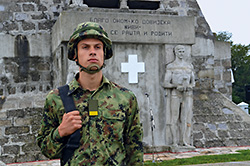 The Battle of Mačkov Kamen is also known as the ”officers’ battle”, because of great losses in the Serbian officers’ staff. Officers, charging as leaders of their units, gave an example with their heroism of how one should fight for freedom. As many as 115 of them never returned from the battlefield and 176 were wounded. Many units were left without officers. Majors and captains took over command over regiments, lieutenants and sub-lieutenants over battalions, sergeants over troops. The Battle of Mačkov Kamen is also known as the ”officers’ battle”, because of great losses in the Serbian officers’ staff. Officers, charging as leaders of their units, gave an example with their heroism of how one should fight for freedom. As many as 115 of them never returned from the battlefield and 176 were wounded. Many units were left without officers. Majors and captains took over command over regiments, lieutenants and sub-lieutenants over battalions, sergeants over troops.
Austro-Hungarian commanders informed that the defense of Serbian officers is incredible and their charges remarkably daring. According to Austro-Hungarian reports, the fights in Mačkov Kamen were fiercer than all previous ones, while their historians noted that it was the bloodiest battle in their entire invasion on Serbia.
After taking over Serbian positions on September 22, Potiorek ordered moving into defensive position. It was such a battle that he no longer had the strength to continue the attack, which enabled the Serbian army to withdraw undisturbed. At the very battlefield, according to Austro-Hungarian sources, there were two thousand dead soldiers, thereof 800 Serbs. Their lists also state how many bodies were found as a whole, while numerous ones were torn by horrible artillery fire. Austro-Hungarians did not even refrain from firing at soldiers of both sides during their hand-to-hand combats. The ”dum-dum” bullets, which the enemy used abundantly, also made terrible losses among the Serbian forces. The Battle of Mačkov Kamen caused the death of more than 8.000 Serbs and about 30.000 Austro-Hungarians.
NEVER SEEN BEFORE
The bloody fights in Mačkov Kamen did not bring rest to the fighters in Gučevo. Serbs tried to neutralize the actions of the superior enemy artillery by getting as close as possible to the Austro-Hungarian trenches. In some places, the sides in conflict were only about ten meters from each other.
– In order to destroy the Austro-Hungarian machinegun nests, Serbian soldiers dug a tunnel leading to the Austro-Hungarian trenches. Miners from Veles were digging so that a hunched soldier could pull a crate of dynamite. The passageway was dug between two enemy nests, then forked. When the explosive was activated, enormous quantities of soil and stone went up into the sky, while blown up soldiers in blue uniforms could be seen above the cloud of smoke. The explosion was so forceful, that the soil also fell over Serbian trenches and covered 20 people. Six of them managed to save themselves. Craters can be seen on the mountain even today – tells Žarko Ćosović from the ”Battle of Drina” Memorial Gallery in Banja Koviljača.
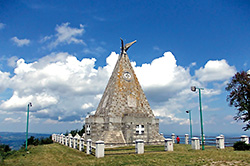 He also reminds of the story about the hunter whose dog started digging in Gučevo. The hunter then noticed a bayonet sticking from the ground and dug out a skeleton of a Serbian soldier. In a semi-upright position, with a gun in his hand, he was covered with soil and thus remained on eternal guard. There were so many dead people left scattered in this beautiful mountain, that, decades after the war, shepherds were discovering skulls and bones. After visiting Loznica and Gučevo, John Reed, New York Magazine reporter, wrote in his book War in Serbia 1915: He also reminds of the story about the hunter whose dog started digging in Gučevo. The hunter then noticed a bayonet sticking from the ground and dug out a skeleton of a Serbian soldier. In a semi-upright position, with a gun in his hand, he was covered with soil and thus remained on eternal guard. There were so many dead people left scattered in this beautiful mountain, that, decades after the war, shepherds were discovering skulls and bones. After visiting Loznica and Gučevo, John Reed, New York Magazine reporter, wrote in his book War in Serbia 1915:
”Serbian trenches were on one side of this open space, Austrian on the other. There was hardly ten meters between them. Both trenches were joining into enormous pits here and there, about a dozen meters in diameter and about fifteen deep, in places where the enemy was blown up with dynamite. Taking a better look, we saw a horrible thing: pieces of uniform, skulls with matted hair, from which rags of flesh were still hanging, bones with rotten hands at their end, bloody bones sticking out of military boots, were all jutting out of these mounds of dirt. A terrible smell was hovering over the entire area. Packs of semi-wild dogs ran away to the edge of the forest... We were walking over the dead. There were so many of them, that sometimes our feet would fall into pits of rotten meat, crushing the bones. Holes would suddenly open, with gray maggots swarming over them. Most bodies were covered only with a thin layer of dirt, partially washed down by rain, while many were not buried at all. Numerous Austrians were laying as they fell in their desperate attack, packed on the ground in a position of full movement.”
FOR THE STRENGTH OF THE FUTURE UPHEAVAL
Serbian soldiers saw the new weapons of the enemy for the first time in Gučevo, which often provoked horror in experienced fighters. It was difficult to remain calm while light rockets burned above their heads, while they were shot with perfidious weapons with pneumatic pressure or those with horrible blasting, rifle grenades, exploding bullets, smoke and gas grenades. On the other hand, Serbs were short in ammunition and equipment. In his book Battle above the Clouds, Branimir Ginić writes about the ingenuity of the Serbian soldiers in such circumstances.
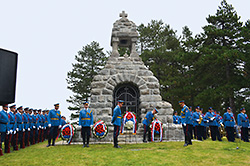 ”Commander of the 5th Supernumerary Regiment Nikolajević issues an order: ‘Pay attention to the enormous spending of ammunition. I order to stop aimless wasting of ammunition. Undertake measures that good soldiers continue shooting, thereby letting the enemy know that we have not languished.’ In order to compensate the lack of ammunition, they used rattles. These shots of false machineguns provoked a strong reaction and nervousness of the enemy. They were made of wooden cylinders, but so perfect in their imitation of real machineguns, that even the most experienced ear could not differentiate them from genuine shots. Rattles were used in close-quarter fighting, with the objective to trick the enemy in their estimation of the number of machineguns and expand the enemy fire towards false machinegun nests. Thus the defenders of Gučevo succeeded in competing with the superior enemy for a long time.” ”Commander of the 5th Supernumerary Regiment Nikolajević issues an order: ‘Pay attention to the enormous spending of ammunition. I order to stop aimless wasting of ammunition. Undertake measures that good soldiers continue shooting, thereby letting the enemy know that we have not languished.’ In order to compensate the lack of ammunition, they used rattles. These shots of false machineguns provoked a strong reaction and nervousness of the enemy. They were made of wooden cylinders, but so perfect in their imitation of real machineguns, that even the most experienced ear could not differentiate them from genuine shots. Rattles were used in close-quarter fighting, with the objective to trick the enemy in their estimation of the number of machineguns and expand the enemy fire towards false machinegun nests. Thus the defenders of Gučevo succeeded in competing with the superior enemy for a long time.”
Serbian soldiers also found ways to inform the command about the situation in the frontline. They wrote messages on empty ammunition cases tin, then lit a candle and raised the cases with a stick. The messages could be read from more than a 200 meter distance.
After almost two months of resisting, the heroic fight of the Serbian army in Gučevo ended on November 6, at dawn. Exhausted defenders had to withdraw. However, the Battle of Drina, especially the horrific combats on Mačkov Kamen and Gučevo, enabled the counterstrikes which were about to take place. Serbia greeted the end of 1914 free, without a single enemy soldier in its territory.
***
Commerce in the Trenches
Austro-Hungarian troops had ammunition and equipment, however lacked food, which was difficult to supply over the fiery Drina (Serbian artillery destroyed bridges). On the other side, Serbs had food, but were short in everything else. Unusual commercial activities thus developed in Eminove Vode, where the trenches were closest to one another. Our soldiers exchanged two loafs of bread for a pair of shoes from the Austro-Hungarians. First Serbs would throw one loaf and, when the shoes would fly from the other side, they would send the other.
***
The Prince and the Painter
During the battle, Serbian regiments conducted fifteen attacks on Mačkov Kamen, as well as numerous counterattacks and attacks of lower-rank units in other parts of the battlefield. Prince Đorđe, son of King Peter I, led the last attack of the 5th Supernumerary Regiment after its commander was killed. Holding a revolver in one and a sabre in his other hand, the brave prince jumped out of the trench commanding: ”Charge, brave ones! Follow me! I am the son of your king!”
The prince was soon shot and became the first patient of nurse Nadežda Petrović, famous Serbian painter.
***
Treacherous Attack
Not far from Mačkov Kamen, there is a place from which wounded Serbian soldiers were transported to Krupanj. In the moment more than 70 of them were waiting for the horse carts to start off, Austro-Hungarians noticed them and opened artillery fire. Paramedic Milutinović, who survived the treacherous attack, raised a monument in the form of a cross there, to honor his comrades.
|
